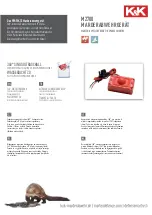
IOM CRUZcontrol® Generation2 for NBC
P/N: 1118211
Revision Date: 05/31/2019
Page
52
of
66
Example 7: NBC-C accumulation release to NBC-N conveyor
NBC-C accumulation release to NBC-N conveyor
Problem
Creating line pressure when feeding a slower conveyor
Solution
Use logic assembly as a discharge logic assembly
Configuration
Place Discharge Logic Assembly (DLA) downstream of conveyor discharge zone.
Set mode to basic. Do not plumb air line to logic assembly.
User Action:
None needed.
Operation
The Discharge Logic Assembly is connected to the Logic Assembly at the
discharge end of the NBC-C conveyor. There is no need for a Function Module to
be attached to it. The DLA does not need to be given a release signal. Product
blocking that photoelectric sensor will stop release from the NBC-C discharge
zone, until the photoelectric sensor clears again. This operation is left enabled and
ready to function regardless of whether the induction conveyor is running or off.
There is no need to interface the CRUZcontrol operation with the induction
conveyor operation, since the functioning of it is based solely on product
movement.
NBC-C conveyor, when accumulating and subsequently releasing accumulated product, will result in
some amount of line pressure at the discharge end of the conveyor. This is caused by the momentum
of moving product coasting to a stop as it accumulates.
Example:
The NBC-C is running at 180 feet per minute, feeding the induction conveyor section prior to a pick
zone module diverter. Without proper control of the discharge from the NBC-C, cartons released to the
induction conveyor could possibly overdrive it and push past the 90 fpm section onto the 180 fpm
section, not permitting product gapping to occur as required for the diverter to function properly.
The mounting location of the Discharge Logic Assembly photoelectric sensor and the reflector will
determine release performance. A good starting point would be to locate the photoelectric sensor 12
inches downstream from the charge end of the induction conveyor, and the reflector 18 inches
downstream from the charge end. The final locations should be determined based on system
performance.














































